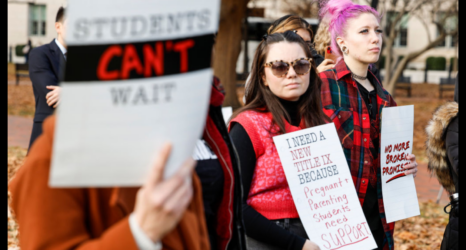Over the past few weeks, news of a 500-word essay assigned as punishment for sexual assault at Gustavas College in Minnesota and of a series of sexual harassment charges filed against faculty at UC Berkeley have put campus sexual violence back in the national spotlight. These stories have focused on how Title IX—the federal law that prohibits sex discrimination in education—and the Clery Act, which mandates data collection on campus crimes, among other things, must be used to hold institutions accountable for turning a blind eye to, or mishandling, charges of sexual misconduct.
While Title IX and the Clery Act are indeed powerful levers for change, they do not, in and of themselves, build campuses and communities that are free of sexual violence. There needs to be more attention to prevention strategies. Doing that means challenging binary understandings of “masculinity” and “femininity” that justify the beating up of gender queer students and that sanction men’s sexual access to female bodies. It means exposing how sexism is racialized and recognizing the legacy and persistence of racialized violence and the perpetration of violence against women of color. More attention to prevention means, in other words, an “intersectional” approach to sexual violence—one that recognizes the intersecting hierarchies of race, gender, sexuality and other forms of power. The experiences and needs of female students, students of color and of LGBTQ students should front and center in all attempts to eradicate sexual violence.
Data from recent national surveys call out for such a response. The Association of American Universities (AAU) Campus Climate Survey on Sexual Assault and Sexual Misconduct, released in the fall of 2015, found that rates of sexual assault and misconduct are highest not only among undergraduate cisgender female students, 1 of 4 of whom experienced some form of unwanted sexual contact during their college careers, but also among students identifying as transgender, genderqueer, non-conforming and questioning, as well as among students with disabilities. (Cisgender, a term that the AAU survey did not use, denotes someone who identifies with the gender assigned at birth.)
In addition, a recent White House report on sexual assault (not only on college campuses) revealed that women of color disproportionately experience sexual violence. It found that 33.5 percent of multiracial women, 27 percent of American Indian or Alaska Native women, 22 percent of black women, 19 percent of white women and 15 percent of Hispanic women have been raped. A recent United Nations shadow report drafted by Black Women’s Blueprint states that violence against women of color and LGBTQ people of color continues to be an underreported problem.
This is no easy task and great work is already being done. Here are four suggestions to consider:
- Make Current Policies and Resources Intersectional
Policymakers and personnel charged with addressing sexual assault on campuses should be made sensitive to the different needs of a diverse student population. They should, for instance, be aware that requiring students or campuses to go to the police (as stipulated in the Safe Campus Act, now before Congress) would make many students less likely to report rape, given the fact that police have been perpetrators of sexual violence, especially against women of color and trans women.
Educational and prevention programs for students should also be intersectional. For example, First Year Campus Acquaintance Rape Education (FYCARE) programs should incorporate mixed-gender breakout groups and inclusive language for different gender identities and sexualities. Educating students, for example, about preferred gender pronouns, the connections between sexual assault and hate crimes, racialized gender stereotypes, and how people with different physical and mental abilities express consent, should be part of a comprehensive anti-violence strategy.
- Make Sex Education Part of Educational Efforts
Educational efforts should include information about sex, sexual health and sexuality at every level of schooling. In many states, high school students receive an abstinence-only education. These students do not learn what consent is, to say nothing of contraception or healthy attitudes towards sexual health. “Safe sex” campaigns would promote conversations about contraception among partners and would help lead to an understanding of affirmative consent. These conversations should explicitly embrace those with different gender identities, expressions and sexualities, and also educate students about discrimination that trans and genderqueer students face in bathrooms and other gendered spaces on campus (the documentary Toilet Training is a great resource). Campus resource centers with ongoing programming as well as online learning modules that offer students an incentives would help make this educational outreach part of the campus culture.
- Expand Prevention Strategies to Change the Campus Climate
Universities should broaden prevention strategies beyond the current focus on individual behavior (bystander intervention, consent and risk reduction that individuals can take, such as not drinking heavily), to include structural ways that the campus recognizes gender, sexual and racial diversity. For example, in order to combat the persistent harassment and violence that genderqueer and trans students face in gender-segregated bathrooms, universities should prioritize providing gender-neutral restrooms around campus. Campuses could also diversify student-housing options for LGBTQ students and provide readily accessible counseling and health services that include counselors who are not only attuned to the needs of a diverse student population, but who also reflect that diversity themselves.
Prevention programming should be ongoing and not limited to one-time events for first-year students and new employees. Course syllabi should include a statement about sexual assault and misconduct, including campus resources and policies, and this information should also appear on the front page of college and university websites.
Curriculum could also address intersectional approaches to sexual violence. Most schools have courses on these subjects, including gender violence, sexual health, anti-discrimination law, disability studies or the political uses of sexual violence. It is not a radical idea to require students to take courses that would deepen their grasp of sexual violence, racialized sexual violence, and violence against LGBT, non-cisgender, and differently abled people. Such a course may profoundly alter their personal lives.
- Look to Students for Advocacy and Leadership
Schools should listen to student demands. Students have been at the forefront of the Know Your IX movement, and mobilized anti-violence activism such as the Clothesline Project, 7000 In Solidarity, Men Against Rape and Sexual Assault and It Happens Here, as well as the continuing activism of Take Back the Night. Student leaders in the Black Lives Matter movement have also drawn connections between racial and sexualized violence, police brutality and the institutionalized racism of the academy. Leaders of Black Lives Matter have raised attention to the many women who have been victims of sexualized police brutality through #SayHerName, and have brought attention to sexual assault and harassment of LGBT people of color by the police. These activists should be involved in crafting prevention programs as their voices are vital to understanding systems of violence.
Over the past several years, the work of students, activists and feminist lawyers, has revolutionized how universities and colleges respond to and address sexual assault. More and more, through the use of Title IX, institutions are being held accountable and are finally addressing a problem long ignored and mishandled by campus administrators. The federal government has also given unprecedented attention to matters of campus sexual assault and misconduct.
Yet, as the continuing battles against campus sexual assault reveal, Title IX and the Clery Act don’t offer all the answers. Our efforts to eliminate sexual assault on our campuses require fundamental changes that promote inclusivity and empowerment for all, regardless of race, gender, sexuality, class, and able-bodiedness. By listening to students, changing campus climate, promoting sex education, and making our existing policies intersectional and inclusive, we can go a long way to eliminating campus sexual assault and misconduct. We can eradicate violence and discrimination from our campuses by creating campuses that are committed to the safety, education, health and freedom of all students and staff.
Get the Ms. Blog in your inbox! Click here to sign up for our newsletter.
Photo courtesy of Flickr user Wolfram Burner licensed under Creative Commons 2.0





